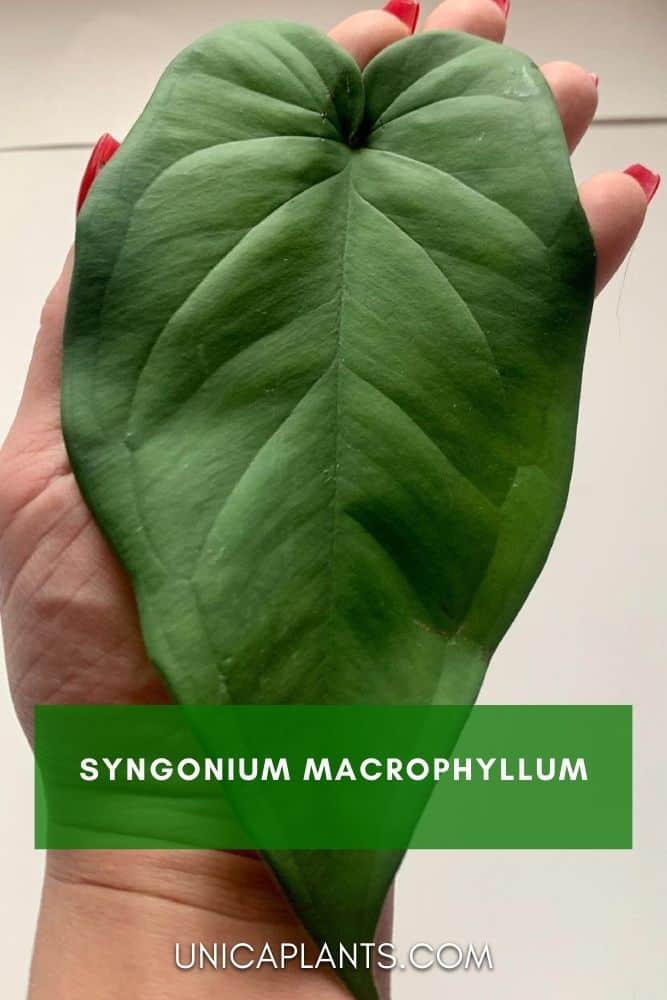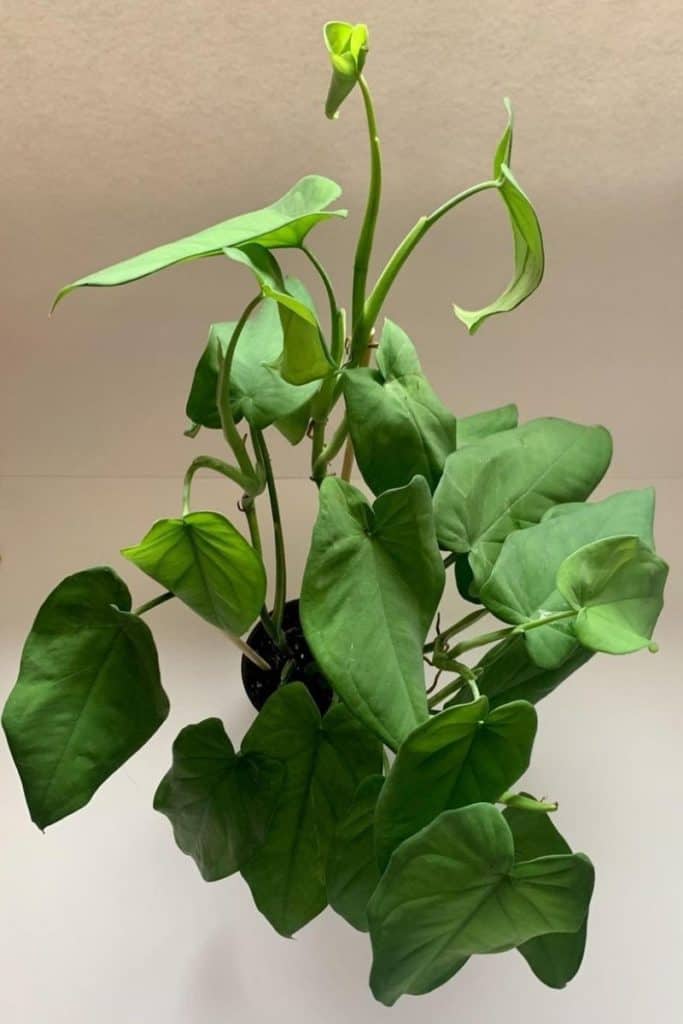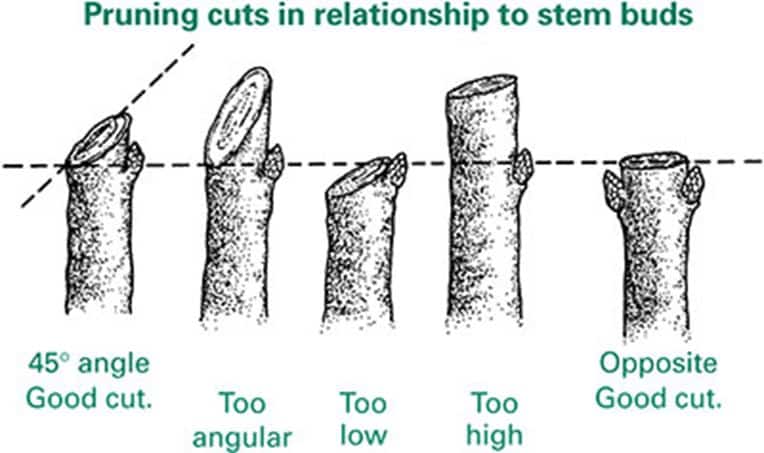This vining plant is perfect if you are looking for a unique house plant that is easy to care for. In this care guide, you will learn exactly how to grow and care for the Syngonium macrophyllum.
This exotic plant is hard to find, which is why it is so rare. What makes this plant so unique is the color and texture of the foliage. The leaves have a leathery texture and a bright emerald green color which is quite unusual for the Syngonium.
Native to tropical areas from Mexico to Ecuador, this is a perfect house plant for beginners because it is hard to kill and doesn't require specific care. It will vine up to 10' (3 m) with leaves that can grow up to 8" (20 cm).
This beginner-friendly plant will tolerate low light conditions but will grow at a fast rate if you give it lots of bright indirect sunlight. Besides, this plant is very easy to propagate and has almost no pest issues. More of that in a minute.
Images by Jamie from AtlanticBotanical

Summary:
- Light: Bright indirect sunlight
- Water: Only water when the top 2 inches of the soil are dry
- Soil: Well-draining potting soil
- Fertilizer: Once every month (only in spring and summer)
- Size: The plant vines up to 2' (60 cm) tall
- Size: The plant's leaves grow up to 8" (20 cm) long
- Temperature: Between 64 and 95ºF (18 and 30ºC)
- Humidity: Normal
- Cold hardy: Not cold hardy
- Propagation: By stem cuttings or air layering
- Toxicity: Can be toxic to humans and animals
Contents
General Care for Syngonium macrophyllum
The Syngonium macrophyllum is very easy to grow and only needs a little bit of love to grow and stay healthy. It can be grown as an indoor plant or outdoor plant (USDA zone 11) and will be hard to kill. Now, let's start with the good stuff!
Light
This plant will thrive best when receiving lots of indirect bright sunlight or dappled sunlight. A couple of hours of direct sunlight per day won't hurt the plant. However, keep it away from too much direct sunlight because this will eventually burn the leaves.
A great thing about this plant is that it will also tolerate low light conditions. This doesn't mean it can survive without any light. Every plant needs light in order to survive, but the Syngonium macrophyllum would be perfect if you live in a basement or an apartment where there is not much light. Even in these scenarios you can still grow this plant and enjoy its presence!
But...
You have to keep in mind that lower light conditions will result in smaller leaves and a slower growth rate.
Water
Syngonium macrophyllum is a plant that likes to have its soil fairly dry in between waterings. As a rule of thumb, you only want to water this plant when the top 2 inches (5 cm) of the soil get dry. It's also not a problem if you forget one watering once in a while.
When to water this plant also depends on the weather conditions. If the plant receives more sun, it needs more water. If it's winter and the plant doesn't receive as much sun, the plant needs less water.
Do not overwater or keep the soil wet for too long, as this will encourage root rot. If leaves are yellowing due to overwatering, skip a week or two of watering.
A tool you can use to never forget to water this plant is a moisture probe. This probe will indicate how much moisture there is in the soil. For the Syngonium macrophyllum, when the moisture probe gets to about 1 or 2, it's time to water the plant. Click here to check out the moisture probe on Etsy.
Repotting & Soil
Repot every three years in a pot that is 1 inch (2.5 cm) bigger. Remember, repotting will cause the plant stress, so you want to repot in spring when the plant is strong enough. When the plant is strong enough, it will easily continue growing after repotting.
For soil, the Syngonium likes to grow in a well-draining potting mix. You can easily make a lightweight and well-draining soil mix at home with general house plant potting soil, perlite, and orchid bark (1:1:1). A good aroid soil mix will also do perfectly for this plant!
Fertilizer
The Syngonium macrophyllum doesn't require a lot of fertilizer. In fact, once a month (only in the growing season) is more than enough. When feeding this plant, you always want to make sure that you use the correct amount. For my plants, I always dilute the fertilizer to ½ or ¼ of its strength. This way you will never use too much.
When it comes to fertilizing plants, I always say: less is more! Using too much fertilizer will cause minerals to built up inside the plant. The excess amount of minerals can burn the leaves and result in a dead plant. Unless you are a plant destroyer (which I hope you are not), you never want to exceed the recommended amounts of fertilizer.
Humidity
There is actually not a lot to say about the humidity needs of the Syngonium macrophyllum, except that it likes normal humidity. Using a humidifier or a mister is not necessary and will not bring more growth or bigger leaves (unfortunately).
Common pests
If you are growing the Syngonium macrophyllum in the right conditions and take care of it correctly, pests are actually very rare. But, when these conditions are not optimal there is a small chance that pests like spider mites, mealybugs, and aphids will infest the plant.
If, however, you are concerned about pests, you can use a neem oil spray. Check out my shop to get a high-quality and organic pesticide with neem oil.

How to Propagate Syngonium macrophyllum
The Syngonium macrophyllum can be propagated by either stem cuttings or air layering. Both methods have the same success rate. However, air layering is not often not necessary and the plant can easily be propagated by stem cuttings alone.
Also, you never propagate a plant in the winter or when the leaves are drooping. Propagating should be done in spring when the plant is strong enough.
Stem cuttings
When propagating the Syngonium macrophyllum by stem cuttings, you want to start at the top of the plant and make your way to the bottom. Always make sure the cuttings you take from this plant have one set of aerial roots and at least 1 leaf. Also be careful not to break these roots, because without roots the cutting will not grow.
If the aerial roots of the cutting are shorter than 1-2 inches (2.5 - 5 cm), then you first want to propagate that cutting in water and wait until the roots become bigger before planting it in soil.
If the aerial roots of the cutting are 2 inches (5cm) or longer, then you can plant them in a well-draining soil mix. You can easily make a perfect soil mix for the macrophyllum with general house plant potting soil, perlite, and orchid bark (1:1:1). You can also use a good aroid mix (check out my shop).
After you have planted the cuttings, care for them just like you would normally, and enjoy your propagation!
Air layering
You should only choose air layering when the aerial roots of the plant are shorter than 2 inches (5cm). Otherwise propagating this plant with stem cuttings will do just fine.
To use this method, you want to use a plastic bag and fill it with a big hand full of sphagnum moss. Now wrap the plastic bag with the sphagnum moss around the aerial roots. Make sure you use enough moss to cover up the node above and below the aerial roots as well. This will encourage the plant to grow the aerial roots into the sphagnum moss.
Once you get the sphagnum moss pressed up against the roots and nodes you want to secure that position by putting some twisty ties around the bag. Also, you want to poke a couple of holes in the plastic bag to provide oxygen for the roots.
For the next two to four weeks, keep the moss damp (not soaked) with regular tap water. If, however, the moss has been too wet, there is a chance that the roots will start to rot. To avoid this, don't water too frequently and make enough holes in the plastic.
If you have done everything right, you should see the roots growing inside the bag with the moss.
Four weeks after you have put the plastic on, carefully remove the plastic bag with the moss. Then cut 1 inch (2.5 cm) below the newly grown aerial root and plant the cutting in a well-draining potting mix.
If you liked this care guide, check out 16 indoor plants that produce the most oxygen!



Leave a Reply